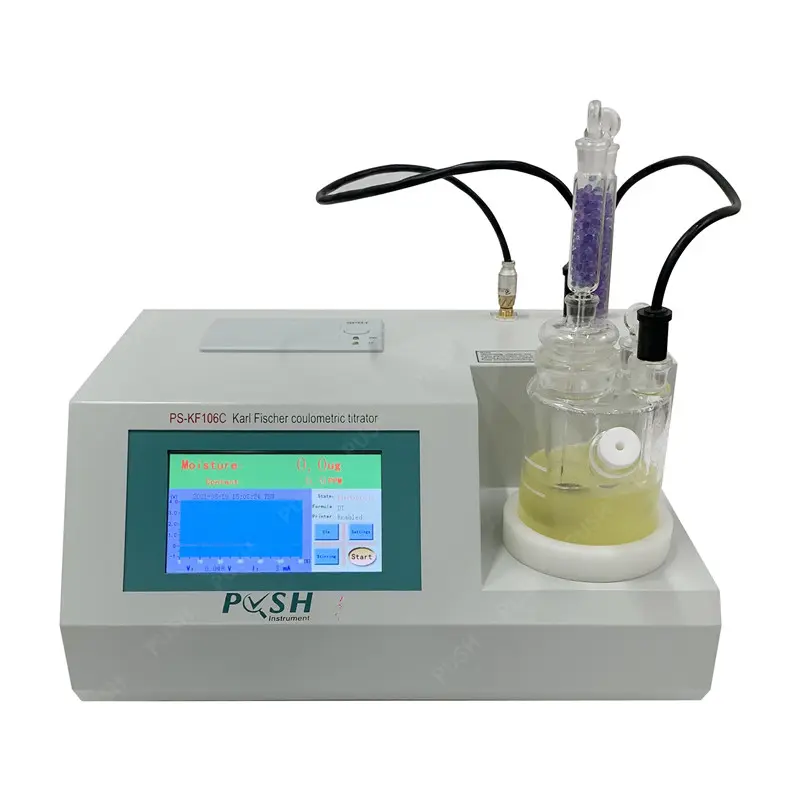An OEM Karl Fischer Moisture Analyzer is an analytical instrument used to measure the moisture content of various substances accurately. It is based on the Karl Fischer titration method, which is a widely recognized and precise technique for moisture analysis.
Here’s an explanation of what an OEM Karl Fischer Moisture Analyzer is and how it functions in moisture content analysis:
OEM Karl Fischer Moisture Analyzer:
- An OEM Karl Fischer Moisture Analyzer is a specialized moisture measurement device that can be incorporated into other equipment or systems as an original equipment manufacturer (OEM) component. It is designed to provide moisture content data in real-time or as part of an integrated process.
Function in Moisture Content Analysis:
- The Karl Fischer titration method is used to determine the moisture content in various materials. It relies on the chemical reaction between water (moisture) and a Karl Fischer reagent.
- Here’s how the OEM Karl Fischer Moisture Analyzer typically functions:
- Sample Introduction: A small sample of the material being tested is introduced into the analyzer. This can be done through various means, including automated sample handling systems.
- Titration Cell: The sample is mixed with a Karl Fischer reagent solution in a titration cell. The reagent contains chemicals that react specifically with water molecules.
- Chemical Reaction: Water molecules in the sample react with the Karl Fischer reagent, producing a change in the titration cell’s electrical properties. This change is directly proportional to the amount of moisture present.
- End Point Detection: The analyzer continuously measures this change until it reaches a stable endpoint, indicating that all the moisture in the sample has reacted.
- Calculation: The analyzer calculates the moisture content based on the volume of reagent consumed during the titration, and this value is typically displayed on a screen or transmitted to a control system.
Significance:
- Accurate moisture content analysis is critical in various industries, including pharmaceuticals, food production, chemical manufacturing, and materials science.
- In the pharmaceutical industry, it ensures the quality and stability of drug formulations.
- In food production, it helps maintain product quality, shelf life, and safety.
- In materials science, it assists in understanding the effects of moisture on materials’ properties.
OEM Karl Fischer Moisture Analyzers serve as valuable components in industrial processes and quality control, allowing for real-time monitoring and control of moisture levels to ensure product quality and consistency. These analyzers are commonly integrated into production lines and laboratory equipment, enabling manufacturers to meet specific moisture content standards and regulations.
How is the accuracy and reliability of moisture content testing ensured, including calibration and quality control measures?
Ensuring the accuracy and reliability of moisture content testing, including calibration and quality control measures, is crucial to obtaining precise and consistent results.
Here are some key steps and considerations for maintaining the accuracy and reliability of moisture content analysis:
- Calibration:
- Regular calibration of the Karl Fischer reagents and the analyzer is essential. Calibration involves establishing a relationship between the instrument’s response and the known moisture content of standard samples.
- Calibrate the instrument with a range of samples that span the expected moisture content of the materials being tested.
- Standard Operating Procedures (SOPs):
- Develop and follow standardized operating procedures for sample preparation, analysis, and data recording. OEM Karl Fischer Moisture Analyzer Content Ensure that personnel are trained on these procedures.
- SOPs should include details on sample size, sample handling, reagent preparation, and titration conditions.
- Quality Control Samples:
- Analyze quality control samples regularly to check the performance of the analyzer. These samples should be of known moisture content and used to verify that the instrument is functioning correctly.
- Quality control samples can be internal standards or certified reference materials.
- Reagent Handling:
- Store Karl Fischer reagents properly, following the manufacturer’s recommendations for storage temperature and handling procedures.
- Ensure that reagents are replaced when they approach their expiry date to maintain accuracy.
- Blank Determinations:
- Conduct blank determinations by analyzing reagent and solvent alone (without a sample) to account for any background moisture content. This ensures that the analyzer is not detecting moisture from the reagents or environment.
- Instrument Maintenance:
- Regularly maintain and service the analyzer as per the manufacturer’s guidelines. This includes cleaning, replacing worn components, and ensuring that the electrodes and titration cell are in good condition.
- Temperature and Humidity Control:
- Maintain consistent temperature and humidity conditions in the laboratory or testing environment. Variations in temperature and humidity can affect the results.
- Sample Handling:
- Handle samples with care to avoid contamination. Use clean and dry utensils and containers for sample preparation.
- Minimize exposure of samples to the ambient environment to prevent moisture absorption or evaporation.
- Data Validation:
- Implement data validation checks to identify and address irregularities or outliers in the results.
- Review the results for consistency and ensure that they align with the expected values for the materials being tested.
- Training and Competency:
- Ensure that personnel operating the analyzer are adequately trained and competent in using the equipment and conducting moisture content analysis.
- Documentation:
- Maintain detailed records of calibration, quality control, and analysis procedures. These records are essential for traceability and audit purposes.
- Audit and Review:
- Periodically audit the moisture content testing process to identify areas for improvement and ensure adherence to quality control measures.
By consistently following these measures and guidelines, laboratories and industries can maintain the accuracy and reliability of moisture content testing using Karl Fischer Moisture Analyzers. This is critical for quality assurance and compliance with industry standards and regulations.
